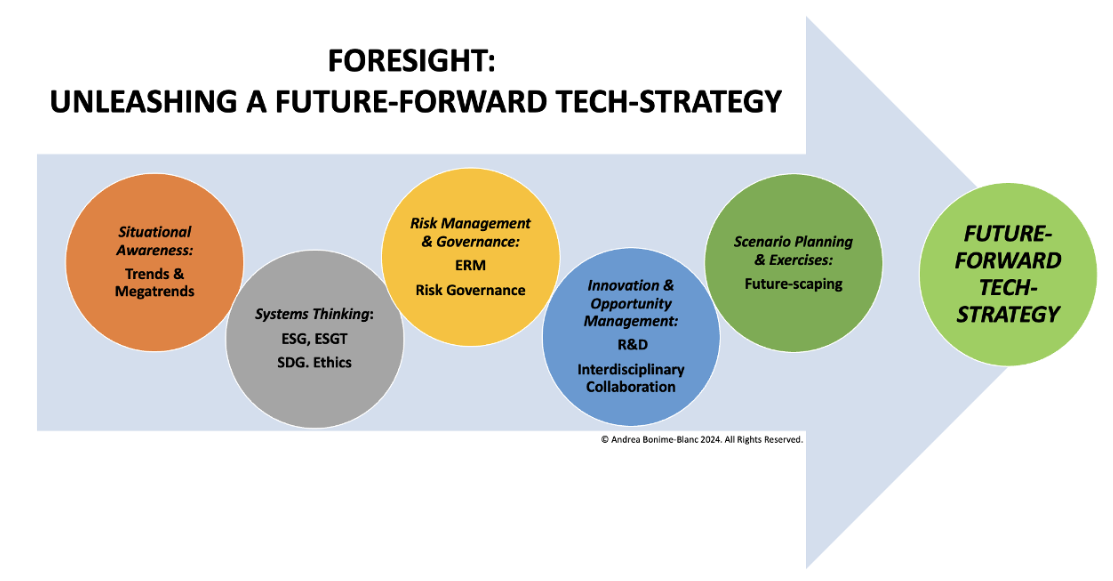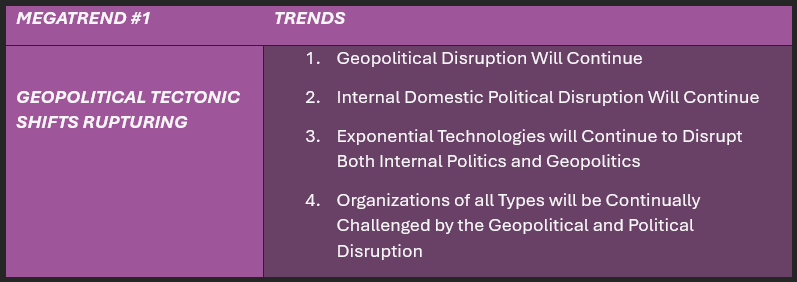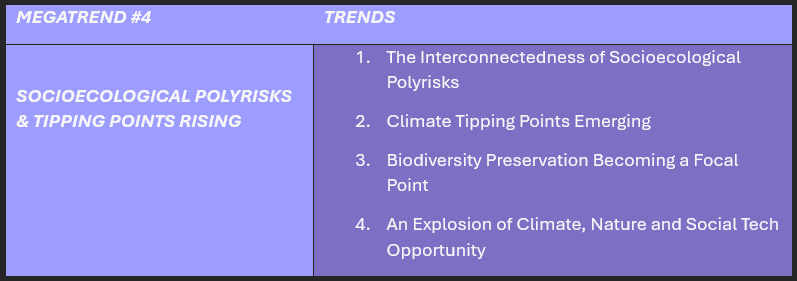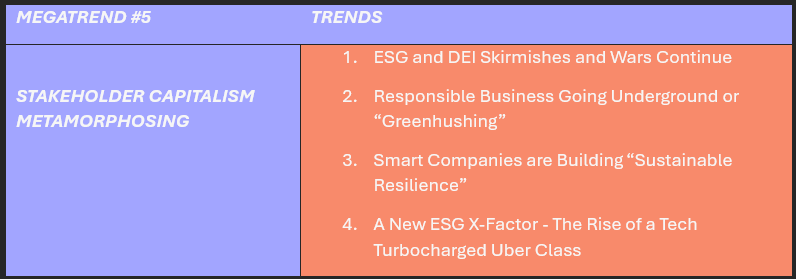The Global ESGT Megatrends 2025-2026 | #Conclusion - An actionable leadership blueprint


· 12 min read
This article is part of a seven-piece series on the Global ESGT Megatrends 2025-2026. You can find the previous piece here.
We first summarize the Megatrends and trends. Then, we conclude with the Megatrends Leadership Blueprint of actionable “to dos” for this coming year. The bottom line message: there is a lot going on, we need to adopt situational awareness to the best of our abilities to understand our key issues, risks and opportunities and build long term, sustainable resilience.
Leaders – from whatever sector, geography or purpose – must exercise situational awareness on behalf of their organization – whether public, private, civic or otherwise – to achieve and fulfil responsibilities to key stakeholders. The primary purpose of The Global ESGT Megatrends for 2025-2026 is to help these decision-makers to identify some of the critical, big picture, multi-year developments in the context of what is going on right now and with a view to the coming 1-2 years.
Establishing a situational awareness baseline is only the beginning as by definition such awareness is and should be constantly adapting, requiring the continuous considered attention of leaders. And situational awareness helps leaders to develop a Foresight Strategy. As I describe in my forthcoming book on future governance, Governing Pandora, a future-forward strategy begins with “situational awareness” and continues with four additional elements - “systems thinking”, “tech-risk intelligence”, “tech-opportunity readiness”, and “interdisciplinary scenario planning”. See Figure below.

Source: A. Bonime-Blanc. Governing Pandora: Leading in the Age of Generative AI and Exponential Technology. Georgetown University Press 2026.
Before we unfurl the Global ESGT Actionable Leadership Blueprint, below are summaries of each of the Megatrends and trends relating to each of the five Megatrends for 2025-2026.
In Megatrend #1 – Geopolitical tectonic shifts rupturing considers the extreme change that is taking place geopolitically and politically affecting international, national and organizational planning, strategy and governance. In doing so, we examine four trends listed in the Table below that are influencing change in this space.

The key take-away? We are at a material inflection point in how international relations (diplomacy and conflict) and internal politics (especially within democracies) are being carried out and business, government and civil society – regardless of role and responsibility - must be prepared for reverberations we cannot fully predict or understand.
In Megatrend #2 – Leadership trust recession we focus on a critically important piece of the global puzzle – the decline in leadership trust worldwide which obviates the need for good to great leaders to exist in all sectors. Without such leaders to represent, protect and further the interests of their key stakeholders, trust will continue to decline with negative consequences for all. Four trends are examined as listed in the Table below.

The key take-away? Stakeholders and especially those with agency and power need to ensure that a better class of leader – emotionally intelligent, humble, curious, inclusive and forward looking – is increasingly sought and secured in all contexts – government, business, and society.
In Megatrend #3 – Exponential technology unfettered we consider the vortex of technological change taking place all around us and some of the key trends that are supporting this unprecedented change. We haven’t seen anything yet. See Table below summarizing these trends.

The key take-away? All companies and organizations are now tech organizations - whether they want to be or not. All types of leaders and decision-makers must gain proper situational awareness of how technology – including exponential technologies like GenAI, advanced materials, biotech and automation (to name just a few) – affect and will affect their value proposition and key stakeholders.
Megatrend #4 – Socioecological polyrisk and tipping points rising the gist of this megatrend is that the socioecological triangle – climate + biodiversity + humanity – i.e., life on earth, is quickly moving into a permanent state of polycrisis, polyrisk and imminent planetary tipping points from which we may be unable to recover. See the trends listed in the Table below.

The key take-away? All of us have a stake and a responsibility in understanding, interpreting and preventing further socioecological polyrisks and polycrises as these are rising and multiplying and serious tipping points may become unpreventable. This includes deploying advanced climate tech asap.
In Megatrend #5 – Stakeholder capitalism metamorphosing we consider the challenges to and path that stakeholder capitalism – and other potential variants like regenerative capitalism and tech associated oligarchical/plutocratic capitalism – may be taking and try to understand how some of the trends – listed in the Table below – are affecting this trajectory.

The key take-away? Stakeholder capitalism and its associated ESG and DEI components are under attack in the largest world economy for now. Despite these headwinds, smart businesses and others continue to embed sustainability into strategy and resilience building mainly because there is no rational alternative given the larger ESGT megatrends and trends taking place.
Below are the suggested leadership and decision-makers actions we suggested at the end of each Megatrend article, gathered in one continuous Table to facilitate a birds-eye view of what I call the Global ESGT Megatrends Actionable Leadership Blueprint to consider for the next 1-2 years.
|
THE GLOBAL ESGT MEGATRENDS 2025-2026: ACTIONABLE LEADERSHIP BLUEPRINT |
|
|
MEGATREND #1 GEOPOLITICAL TECTONIC SHIFTS RUPTURING |
|
|
MEGATREND #2 LEADERSHIP TRUST RECESSION |
|
|
MEGATREND #3 EXPONENTIAL TECHNOLOGY UNFETTERED |
|
|
MEGATREND #4 SOCIOECOLOGICAL POLYRISKS & TIPPING POINTS RISING |
|
|
MEGATREND #5 STAKEHOLDER CAPITALISM METAMORPHOSING |
|
To conclude then, I will repeat here what I stated in the second article of this series (Megatrend #1) published in May 2025: There is only one thing that is certain today – uncertainty. There is only one thing that is predictable today – unpredictability. But it isn’t all about gloom and doom. Indeed, the beauty of uncertainty and unpredictability is that it can also harbor opportunity for unpredictable good-to-great things to happen as well.
And preparedness is the key to success in these uncertain and unpredictable times. With preparation comes resilience and with resilience the ability to survive and even thrive through the darkness and back into the light.
I hope this series has helped you develop a certain degree of situational awareness to translate what these megatrends and trends might mean to you and your organization and encourages you to dig deeper into their implications and impacts on your most important stakeholders and long-term resilience.
illuminem Voices is a democratic space presenting the thoughts and opinions of leading Sustainability & Energy writers, their opinions do not necessarily represent those of illuminem.
illuminem briefings

Electric Vehicles · Public Governance
Gokul Shekar

Effects · Climate Change
illuminem briefings

AI · Ethical Governance
CNBC

Battery Tech · AI
The Washington Post

Electric Vehicles · Public Governance
The Wall Street Journal

Green Tech · Mobility Tech